Returning To Celebrate What They Left Behind?
Or... Postcards from a midlife elsewhere.
I swear I could smell the porcini when I woke up that morning. The sounds of the summer evening parties (music, whoops of celebration, arguments) always float up the hill to our house, why not the scent of the mushrooms?
But standing in our bedroom, breathing in that earthy sweetness, I'm thinking about something I learned in the Borgotaro Mushroom Museum last year, about how the mushrooms are all connected underground by invisible networks called mycelium, stretching for kilometers beneath our feet, linking distant patches in ways you'd never suspect. "Like family," I thought, "You can't see it, but it's there."
Mark's still sleeping, but I know when he wakes, he'll want to head straight to the festival. His family's been tied to these mountains for centuries. His Ancestry DNA shows 99% Italian with a little circle over the only village where the Cabrelli name comes from, which sits just over the ridge in Tuscany. For maybe hundreds of years, his ancestors made their living foraging for porcini. Mushrooms were their lifeblood. Their survival. And yes, it was, and still is, that serious. Families passed down the secret locations through generations, and there are still stories of violence and feuds amongst harvesting interlopers.
When we turn the corner into the main street of town, the scent overpowers us. It's a rich, earthy smell, a round, umami Marmity waft of air with a sweet undertone. If you get a bitter overtone, you aren't smelling Borgotaro porcini, but some mushroom golem from Croatia snuck in during the lean years.
I knew when I woke this morning that we were in for a treat with the weather. It's hot at the Fungo festival this year. Here in the valley nestled in Emilia Romagna, on the border of Tuscany, September is a fickle month. There have been many years where we are bundled in wool sweaters and wandering close to the castagna roasting stations to warm our icy hands, and others, like this one, where we are digging in the back of the bathroom cupboard hunting for the sunscreen bottles left over from the summer and hoping there's some cream left lingering at the bottom.
I'm standing in front of a stall, trying to avoid the stallholder's outstretched hand for several reasons. The first is that his apron is offensive and starkly against the principles of the fair. It's one of those sturdy plastic ones that have a beefy naked chest printed on the front, so it makes the stallholder look like he's naked. I want to say, "Dude, you get attention by having good products, not by wearing a ridiculous, classless apron. Don't you realize you are in Italy on a street where the evening passeggiata happens? That’s a shocking clothing choice on this hallowed fashion ground." That's the other reason I'm trying to avoid his outstretched hand—it's holding a chewy-looking slab of pink meat that looks like it could crawl away and escape if he eased his grip on it.
"Grazie!" Mark says.
Damn it! Mark's taken the sample, so now I have to take the sample, or I look weird standing stopped in front of a stall and ignoring the man's wares (Although I can't ignore what he wears). I take the raw meat (I mean, I think it's raw. I'm used to crudo, but it doesn't usually look like this) and take a polite nibble. Mark chucks the entire slice into his mouth, chews for a few seconds, and then speeds off and disappears into the crowds of festival attendees. I hurry after him, so we don't get separated, and when he appears at my elbow, I give him a questioning look.
"Disgusting," he says, "I had to spit it out."
"I think that's a first," I say. The Fiera del Fungo di Borgotaro never ever has bad food. Walking down into town on this particular weekend is like entering a world of culinary delights.
I drop my sample into a trash bucket along the route, and we avoid that stall for the rest of the weekend. Last night we visited Lori and Roberto’s house (also a B&B) to feast on Lori’s amazing porcini risotto, and they told us a story about a stall-holder who took a room with them for the night and then requested whiskey in his coffee at 7:00am the following morning. I said, “It wasn’t the man with the apron, was it?” and they both laughed, “Yes, yes, it was!” (It just goes to show heroines, you should never ignore your instincts).
A basket of fat porcini stops me in my tracks. We wouldn’t get that back on the plane. It reminds me of how we researched growing porcini in the shaded part of our garden in Scotland. We googled it only to discover that the Borgotaro porcini cannot be farmed (although people have tried to create the conditions, it hasn't worked). They can only be foraged in the wild. They need a specific tree, specific soil, specific weather. When you think about everything that has to go right for them to appear in the undergrowth, you realize porcini are yummy little miracles. At an average of 200 euros per kilo, porcini foraging is still lucrative enough for people to risk their lives for. Roberto works for the Assistenza Publica (the Italian version of EMTs) and told us that every year they rescue folks lost in the forest. Some still die.
A few days earlier, Roberto had taken us on a pilgrimage to meet "his mushroom guy.” It feels like some kind of drug-dealing secret mission when we drive down a dirt-packed lane to a house perched on the edge of a hill. I jump out of the Land Rover (seriously, the step is like 5 feet off the ground, and I have zero grace or coordination), and Bella, the little mongrel guard dog (who turns out to be a lover, not a fighter), tangles in my feet, nipping at my ankles.
The mushroom guy is named Silvano, and when his wife leads us through an archway to the back of the house, we discover that Silvano cultivates a lot more than mushrooms. He has rows and rows of grape vines, vegetables, and fruit galore. He shows me into his forno, where there are stacks of baskets of corn which he grinds into sacks of cornmeal (there are at least ten in the room) and makes his own polenta. He takes me into his storeroom and shows me hundreds of jars of jam, pickled vegetables, and pasta sauce made from his tomatoes. He has enough wine for years, even though he says some years he doesn't get enough grapes to make any.
I say, "You're all set for the zombie apocalypse when it comes; I'm headed here to stay with you."
He laughs, but he's probably just being polite. Silvano doesn't speak English, and I don't translate zombie apocalypse into Italian, because, well, I don't know if it translates.
The last stop, with Bella following me and begging for ear scratches, is the mushroom drying room, where Roberto and Mark are watching Silvano's wife shovel dried porcini into clear bags on a scale. Mark and I will take two hetogram back to Scotland, but Roberto needs a kilo to take down to the family in Puglia. Being in this room is like being inside a mushroom; the smell is so overpowering that it makes my saliva glands hurt from secreting so quickly. The scent lingers on my clothes the rest of the day, as a reminder of the mycelium. That network that keeps mushrooms, and perhaps places and people, connected across distance and time.
Back at the festival, we buy cheese. I can't resist my regional favorite, taleggio, and then the farmer plies me with a goat version, and I am sold. Into my "market bag" it goes. We taste the array of olives and settle on the black ones that you can't find in the US or UK. They have a tangy, bitter taste, like licorice. We pick up our regular supply of vacuum-packed Parmesan from our local caseificio. We’ve toured the factory and stacks of hundreds of cheeses with the farmer several times. He recognizes us and gives us a friendly nod, that small acknowledgment that we’re part of the landscape of this ancient town.
I ponder the chocolate stall, but decide against it, considering that it's 80 degrees outside and we are a long way from going home. Mark can't resist an apple strudel. I wish I liked gorgonzola, because the apricot gorgonzola looks like a scrumptious birthday cake. I take a photo just in case Roberto hasn't seen it yet (later, when we run into them on the street, I discover he's already bought some). We stop at a stall on a quieter side street and taste some delicious pickled onions. I agree to buy a small jar before asking "Quanto costa?" only to be told 10 Euros, and I know it's a tourist price, and I'm a little miffed, but I fork over the money anyway.
We don't buy mushrooms. We already have our connection.
Later that night, Mark and I stop for a vino bianco at Beppe's. We sit in two chairs side by side and facing the street, so we can watch the world go by. Beppe is in full form, shouting insults and compliments to his friends as they pass by, singing along to the accordion that has appeared at the end table filled with old men, a plate of salami, and a few empty bottles of prosecco.
At the next table, I hear cockney accents and start chatting with our neighbors. They, like Mark's family, are from the region and return every year for the summer and autumn festas. We talk about last names, family connections, and dates of emigration, all the visible markers of belonging that people use to map their place in the world.
The town's band marches by, squeezing past tourists, locals, and food stalls. The bass drums shake the wooden platform that Beppe puts out in the summer to get his tables on the street. Beppe is watching them pass, and Mark comments on the reduced number of members from previous years. Beppe nods sadly and tells Mark his uncle used to be in the band.
"Era un amico di tuo papà," he tells Mark (He was a friend of your dad's). Mark's dad passed away thirty years ago, but he is still a presence in this Italian town (the famous Scottish football player).
Standing in Beppe's that evening, listening to cockney accents mix with Italian insults, watching Mark laugh with strangers who somehow aren't strangers, I thought about those invisible networks in the mushroom museum. The mycelium that stretches unnoticed across forest floors, connecting distant patches. And somehow, after years of breathing in that porcini scent each autumn morning, it's growing under my feet, too.
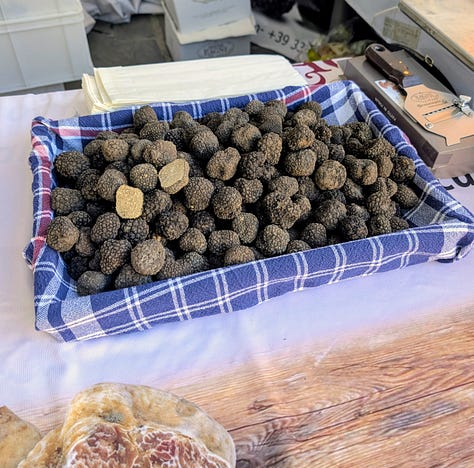
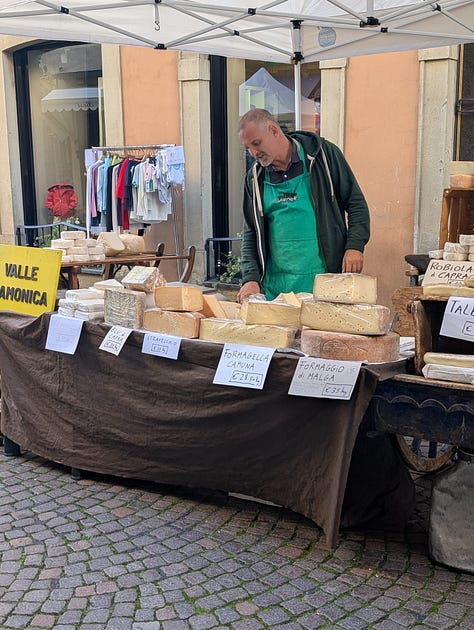
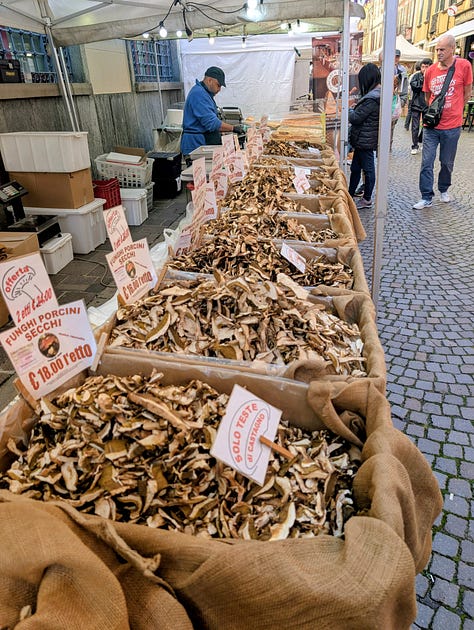
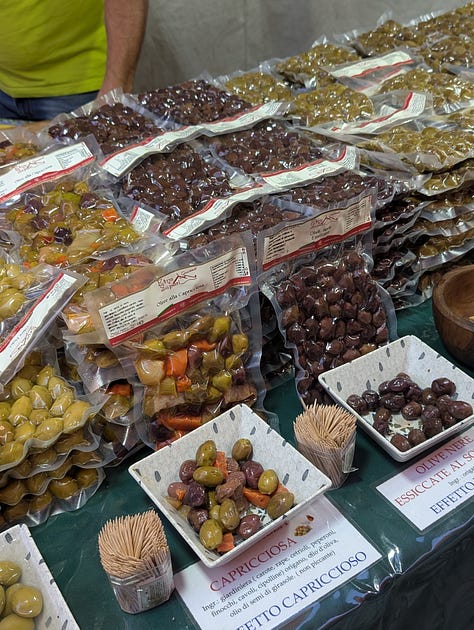
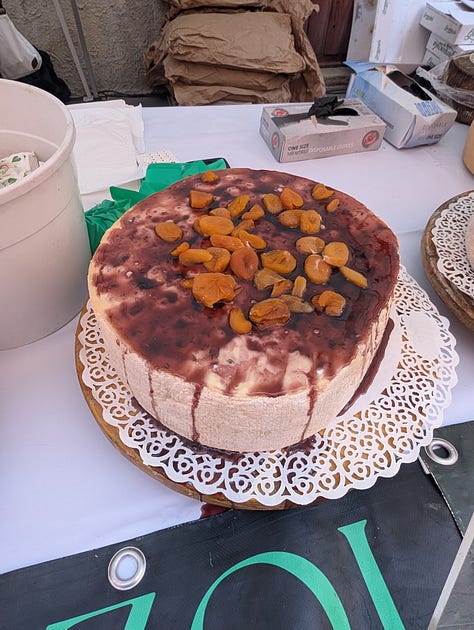
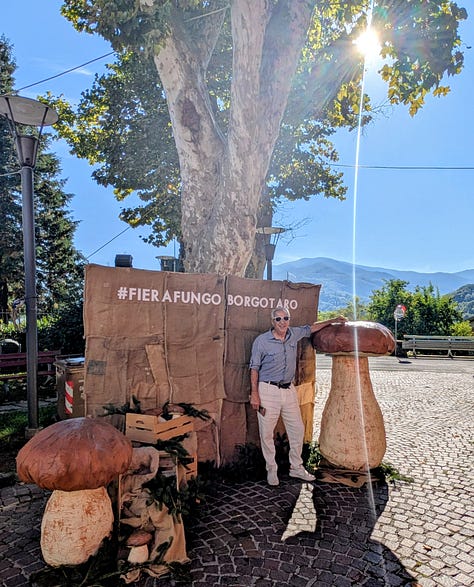
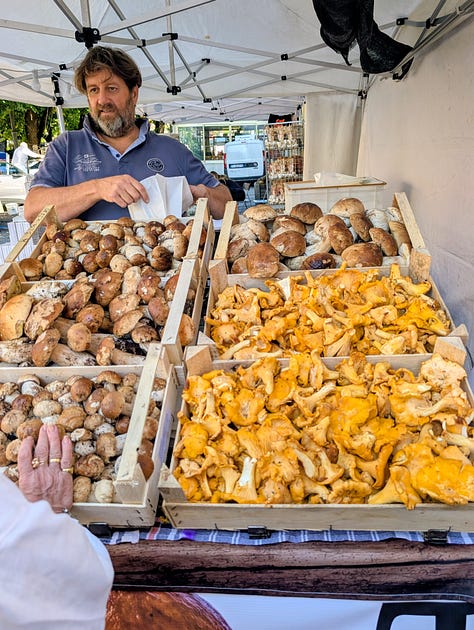
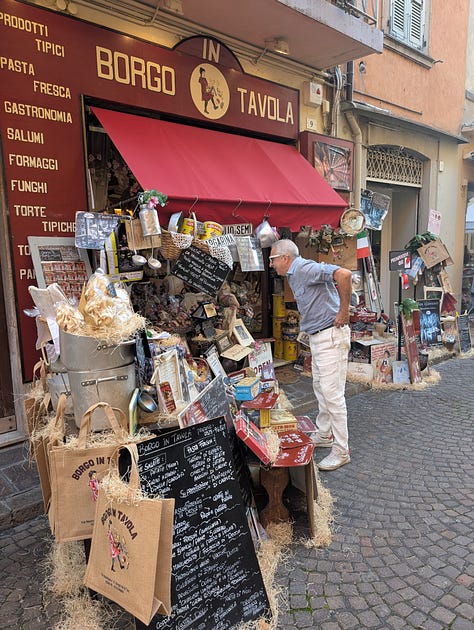
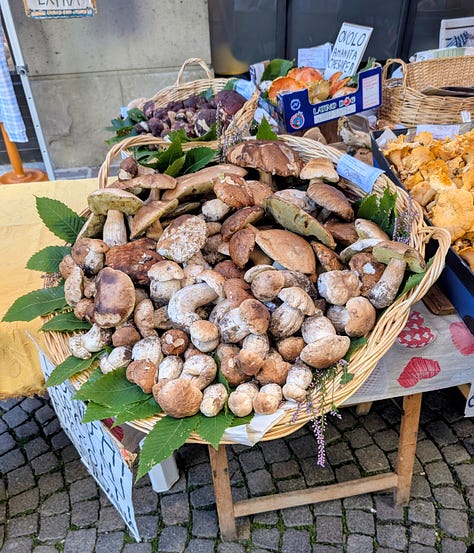
This is a Postcard from a Midlife Elsewhere, a journal of what it means to belong somewhere else…again and again. It’s about relocation, reinvention, and home through stories, snapshots, and reflections from a life lived across borders.
Every place has a doorway. Every midlife has a threshold.
I write about moments that mark the shift from who I was… to who I’m becoming.
Maybe you’ll recognize the terrain.
You can buy your gorgeous, physical, human-centered Heroine’s Adventure workbooks here.



Wow! Is it dangerous to hunt mushrooms still due to "mushroom gang violence"?!